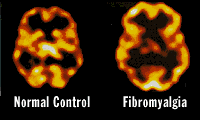 Pain is an everyday experience for sufferers of FM and Myofascial Pain Syndrome. This pain occur in the muscles, joints and anywhere in the body. Pain in the muscles are often described as burning, flu like aching, cramping, shooting or stabbing pain. The management of the pain is often the most debilitating symptom of FM and MPS and the most difficult to manage. Therefore I will add several links related to pain.  The Pain Web Site appears to be in the early stages of development but is apparently being developed to offer factual and research information for health care providers. Site will be good to research, as it develops, to learn what the medical community is doing about pain. Chronic Pain Management Artical on treatment options in treating chronic pain. Bionet.com Pain by Cindy Seiwert. Overview of pain with many links to sites on pain. Pain and Memory Artical on how pain alters the nerves to remember pain. International Association for the Study of PainŽ Medical Newsletters on pain. Contains a lot of articals on pain research. International Association for the Study of PainŽ Pain Definitions. Two good links explaining the types of pain. WHAT WE KNOW ABOUT PAIN Farther explaination about pain. Key ways to understand and assess pain Gives a good explaination of the perception and etiology of pain. This is the summary of the artical. "Summary of key ways to understand and assess pain The perception of and response to pain are widely believed to be determined by four distinct processes: transduction, transmission, modulation and perception. According to the gate control theory of pain, nerve impulses are modulated in the spinal cord by a gating mechanism. Norepinephrine and serotonin are two of the important neurotransmitters involved in pain modulation. Opioid receptors are highly specific binding sites on the end of free nerve endings that bind with endogenous or exogenous opioids and are localized in the ascending and descending pain pathways. Pain may be classified by source as either nociceptive (somatic or visceral) or neuropathic. Pain may also be classified according to the pattern of onset and duration of the pain experience as acute, chronic malignant, chronic nonmalignant. Pain intensity is commonly characterized by words such as mild, moderate, severe, intolerable and excruciating. Pain assessment tools include self-report measurement scales such as numerical ratings, adjective ratings and visual analogs. Pain assessment will vary depending on patient types, including cancer patients, postoperative patients, pediatric patients and patients with specific conditions such as osteoarthritis, rheumatoid arthritis and other similar conditions where pain restricts normal function and activity." CLASSIFICATION AND THEORIES OF PAIN Short but good artical that explains chronic pain and the 3 classifications of chronic pain. "Bonica classifies chronic pain into three groups: persistent peripheral noxious stimulants neuraxis pain learned pain behavior" PAIN AND OTHER STRESSORS Explains in more detail about pain theory and how the immune system responds to pain. A lengthy artical. American Pain Society Imaging Pain: Science and Technology. Artical explains how pain can be detected through brain imaging. Site also has other good and technical articals on pain. THALAMIC BLOOD FLOW ASYMMETRY DURING CHRONIC PAIN Shows images of brain responding to chronic pain. American Pain Foundation Site designed for people suffering from pain includes support and advocacy information. American Chronic Pain Association Another site designed for people suffering from chronic pain and their families. American Autoimmune Related Diseases Association Information related to autoimmune diseases many which causes chronic or reocurring transient pain.   
|